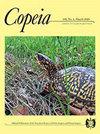Insights into the Nesting Ecology and Annual Hatchling Production of the Komodo Dragon
IF 2.6
Q2 Agricultural and Biological Sciences
引用次数: 2
Abstract
We studied annual trends and characteristics of nesting activities and hatchling production by female Komodo Dragons (Varanus komodoensis) in Komodo National Park, Indonesia between 2002 and 2006. During this period, we recorded 12, 16, 15, 13, and 6 females nesting annually at 42 potential nesting sites. An average female nesting periodicity was estimated at 1.2±0.4 years. This result arose because most females bred annually and some biennially. Some females reused nest sites in successive years while others did not. Nesting females had significantly lower body mass compared to when they were recaptured again in a non-nesting state. All-female nesting activities were conducted within their resident valleys and suggested a strong tendency for spatial fidelity. Komodo Dragons were generally considered solitary nesters as only on one occasion were two nesting females observed to use the same nesting site. On average, 21.0±3.6 Komodo Dragon hatchlings emerged from each nest. We estimated that within the study area, nesting female Komodo Dragons produced between 129.0±21.8 and 344.0±58.16 hatchlings per annum. We discuss the ecological and evolutionary significance of these attributes. However, the main conservation management implications drawn from this study are that there are a low annual number of nesting females and associated hatchling production in Komodo National Park. Hence, a continuation of more extensive nesting surveys could provide a cost-effective and accurate way to gather important long-term demographic information for this species.深入了解科莫多龙的筑巢生态和每年的幼仔产量
研究了2002 - 2006年印度尼西亚科莫多国家公园雌性科莫多巨蜥的筑巢活动和幼崽产量的年度变化趋势和特征。在此期间,我们在42个潜在的筑巢地点每年记录到12、16、15、13和6只雌性产卵。雌鸟平均筑巢周期为1.2±0.4年。产生这种结果的原因是大多数雌性一年繁殖一次,也有一些两年繁殖一次。一些雌性会连续几年重复使用巢穴,而另一些则不会。与在非筑巢状态下再次捕获的雌性相比,筑巢的雌性体重明显降低。所有雌鸟的筑巢活动都在其居住的山谷内进行,显示出强烈的空间保真倾向。科莫多巨蜥通常被认为是独居的,因为只有一次观察到两只筑巢的雌性使用同一个筑巢地点。平均每窝出21.0±3.6只科莫多龙。我们估计,在研究区域内,筑巢的雌性科莫多龙每年生产129.0±21.8 ~ 344.0±58.16只幼仔。我们讨论了这些属性的生态和进化意义。然而,从这项研究中得出的主要保护管理启示是,科莫多国家公园每年产卵的雌性数量和相关的孵化量都很低。因此,继续进行更广泛的筑巢调查可以为该物种收集重要的长期人口统计信息提供一种经济有效且准确的方法。
本文章由计算机程序翻译,如有差异,请以英文原文为准。
求助全文
约1分钟内获得全文
求助全文
来源期刊

Copeia
生物-动物学
CiteScore
2.10
自引率
0.00%
发文量
0
审稿时长
6-12 weeks
期刊介绍:
Founded in 1913, Copeia is a highly respected international journal dedicated to the publication of high quality, original research papers on the behavior, conservation, ecology, genetics, morphology, evolution, physiology, systematics and taxonomy of extant and extinct fishes, amphibians, and reptiles. Copeia is published electronically and is available through BioOne. Articles are published online first, and print issues appear four times per year. In addition to research articles, Copeia publishes invited review papers, book reviews, and compiles virtual issues on topics of interest drawn from papers previously published in the journal.
 求助内容:
求助内容: 应助结果提醒方式:
应助结果提醒方式:


